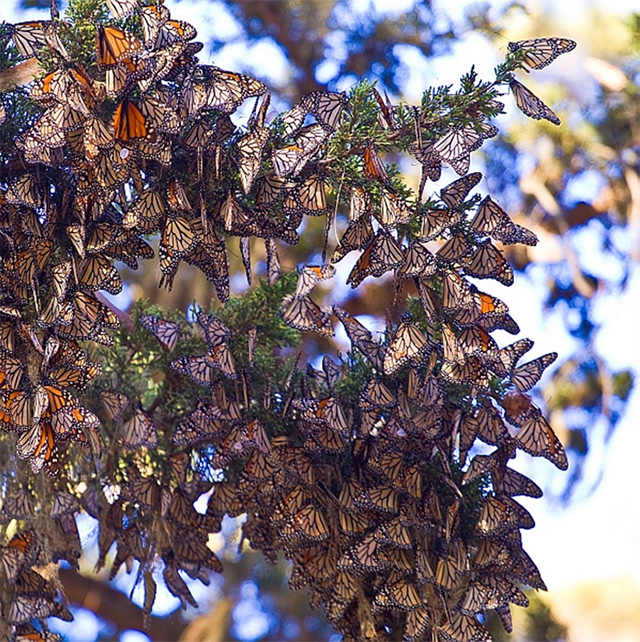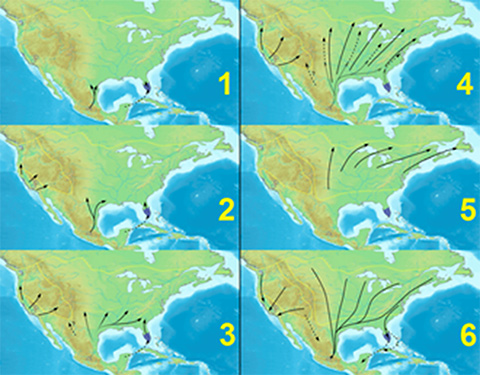
You may have heard that monarch butterflies migrate from Mexico to Canada and back.
But you may be more amazed to know that the returning butterflies are the great-great-grandchildren of the butterflies that left.
Here’s how that works:
The first generation of monarchs leaves Mexico in the spring, pausing to breed and lay eggs as they fly northward.
Their eggs hatch into caterpillars, which eat for two weeks, then metamorphose into butterflies. In four weeks, they too are flying northward.
As the first generation dies, the second generation will fly on, farther north, pausing only to lay eggs of their own. Eventually they too will die, and be passed over by their offspring.
This third generation will finally reach Canada, where they’ll lay eggs.
But the fourth generation that comes from them will be genetically different.
The shorter days and colder temperatures cause these butterflies to develop much larger fat stores, making up a third of their bodies.
And their reproductive organs remain undeveloped—since their purpose is not to breed, but to fly.
Before winter arrives, they’ll make the entire 3,000-mile journey to Mexico—where they’ll seek out the same mountaintops as their great-great-grandparents.
They’ll roost in the same fir trees, congregating in huge masses to hibernate through winter.
In spring, their reproductive organs develop, and they’ll begin their own flying, mating, egg-laying journey, to start the amazing monarch relay, all over again.
Background

2. A monarch caterpillar beginning its pupation on the leaf of a Common milkweed plant. Credit: Captain-tucker [CC BY-SA 3.0 (https://creativecommons.org/licenses/by-sa/3.0)]
3. The protective opaque green chrysalis turns transparent before the monarch butterfly emerges to begin life as an adult. Credit: Hectonichus [CC BY-SA 3.0 (https://creativecommons.org/licenses/by-sa/3.0)]
4. Eastern monarch butterflies overwinter in Mexican forests high in the Trans Mexico Volcanic Belt. Credit: Jaime Rodolfo Sánchez [CC BY-SA 4.0 (https://creativecommons.org/licenses/by-sa/4.0)]
Synopsis: Monarch butterflies travel up to 3,000 mi (4,800 km) during their migrations, and the butterflies that return to the same trees each winter are the great-great grandchildren of the butterflies that rested there a year earlier. Some populations winter in California, some in Mexico, and some just stay year-round in Florida.
- The life cycle of an individual monarch butterfly (Danaus plexippus) is an amazing metamorphosis, but that is just the first part of its journey.
- Monarchs usually lay a single 0.04-in (1-mm) egg on the bottom of a leaf near the top of a plant, which provides food for the larval caterpillar that hatches about three to four days later.
- Females may lay up to 500 eggs in their lifetime, mating multiple times.
- Caterpillars eat their eggshells, then spend 10-14 days eating and growing more than 10 times their original size.
- They shed their skin five times as they outgrow it, eating it before returning to devouring flowers and leaves.
- Caterpillars attach themselves to host plants upside down as they start pupation, forming a hard chrysalis where they undergo metamorphosis over about 10-14 days.
- During this time they must be well camouflaged to avoid predators.
- When the adult emerges, its main job is reproduction.
- Females lay eggs as soon as mating occurs, and both sexes mate several times during their lives.
- As remarkable as their individual metamorphosis story is, their annual migration story is a survival relay race that is just as incredible.
- Monarchs start a remarkable annual migration journey each spring. It takes four or more generations of monarchs to fulfill their annual migration.
- Monarchs that emerge at different times of year actually have different life cycles.
- There are different geographical populations of North American monarchs.
- The distance record goes to the Eastern population, the largest group of monarchs on the continent. The mass exodus from central Mexico expands across much of the United States into southern Canada in three or more generations, then the final generation makes its way back to Michoacán, Mexico.
- The Western population migrates from coastal California northward toward southwestern Canada and eastward toward the Rocky Mountains in three or more generations. Then the final generation makes its way back to coastal California.
- Other global populations of monarchs do not migrate. A small, nonmigrating population stays in Florida and breeds year-round.
- In the Eastern and Western populations, the summer generations of adults start their journey after their month-long metamorphosis in March or April.
- Each insect emerging in the summer is able to reproduce after a few days, and lives for only about five to seven weeks for the sole purpose of breeding as they follow the mild spring weather northward.
- Each generation migrates progressively farther north, mating and laying eggs along the way, which hatch, feed and metamorphose, then mate and migrate farther.
- But monarchs from these populations that emerge in late summer live much longer—for about eight months.
- This final annual generation has a different responsibility than the migrating and mating sprees of the first few generations. Since monarchs can’t survive a long, cold winter, this group must travel all the way back to overwintering sites in milder climates to secure the future of the species.
- Decreasing day length, cooler temperatures and changes in the maturity and quality of available milkweed trigger physiological changes during pupation that make these adults physically and behaviorally different.
- Although these insects look like summer adults, they emerge from their cocoons in “reproductive diapause,” meaning their reproductive organs don’t develop until spring. Their first job is to fly south, then to hibernate, and finally to breed and lay eggs.
- To enable their long journey, the organ that stores fat is larger in this generation. This allows them to accumulate and store lipids, proteins and carbohydrates that provide energy and prevent desiccation. Those returning 3,000 mi (4,800 km) to Mexico develop fat and lipid levels as high as 34%.
- Some researchers have described the summer generations as “sprinters” and the overwintering generation as “marathoners.”
- In the northern part of their range, the two-month migration from southern Canada to California or Mexico starts in late August, and ends precisely where previous generations hibernated the previous winter.
- These aren’t the same insects that left in March—they are a few generations removed—so how do they find their way to the same forests?
- Monarch orientation is mysterious. They use both a sun compass and a magnetic compass. They are genetically different from nonmigrating monarchs.
- They travel during the day, but can orient themselves even when clouds obscure the sun.
- Researchers have shown that insects from migrating populations consistently orient themselves toward the south when they are exposed to shortwave UV light, which penetrates clouds. Otherwise they fly in circles.
- Adult monarchs have magnetic compasses, but the magnetosensors in their antennae are only active in UV light.
- Once they arrive, monarchs cluster together under the protective canopy of the tall trees under very specific conditions.
- Monarchs rely on fog and clouds in their roosting areas to provide moisture needed for their survival.
- They need cooler air, so find locations with consistent temperatures that stay near, but not below freezing.
- They need to roost in trees that provide protection from winter wind, rain, snow and hail.
- Western population adults migrate back to roost in the very same coastal California eucalyptus, pine and cypress trees year after year.
- There are more than 400 historic aggregating sites in protected bays and inland locations that provide shelter from storms.

Monarch butterfly migration: 1) March; 2) April; 3) end of April; 4) April – June; 5) June – August; 6) September – November. Credit: MonarchWanderungKlein.gif: Harald Süpflederivative work: B kimmel [CC BY-SA 3.0 (https://creativecommons.org/licenses/by-sa/3.0)], via Wikimedia Commons - Southward migrating butterflies from the Eastern population return to the same oyamel fir trees on the same mountaintops in the Trans Mexico Volcanic Belt of central Mexico, a trip of 3,000 mi (4,800 km).
- There are only 12 mountaintops in the world with the mild, stable microclimate required for winter survival of this population of monarchs.
- These sites are on steep slopes that face southwest, at elevations of around 9,850 ft (3,000 m) above sea level.
- The butterflies start showing up in their Mexican overwintering sites in late October/early November around the Dia de los Muertos (the Day of the Dead).
- Local villagers believe the brilliant orange butterflies are the spirits of ancestors returning to Earth for a visit.
- As spring approaches and the days grow longer, the hibernating masses begin to stir, initiating three to five weeks of mating activity, starting the annual cycle again.
- In 1980, Mexico set aside 138,000 acres (56,000 hectares) to protect the monarchs’ overwintering areas in the high elevations of the Trans Mexico Volcanic Belt.
- The World Wildlife Fund and the Mexican National Commission of Protected Natural Areas count the acres occupied by the butterflies during overwintering.
- From 1996-1997, monarchs occupied a record 44.5 acres (18 hectares), but in 2013-2014, they occupied less than 2 acres (0.8 hectares).
- In 2017-2018, they occupied about 6 acres (2.4 hectares), down from 7 acres (2.8 hectares) the previous year.
- Improvements have been correlated to habitat preservation and milkweed cultivation along their migration routes.

